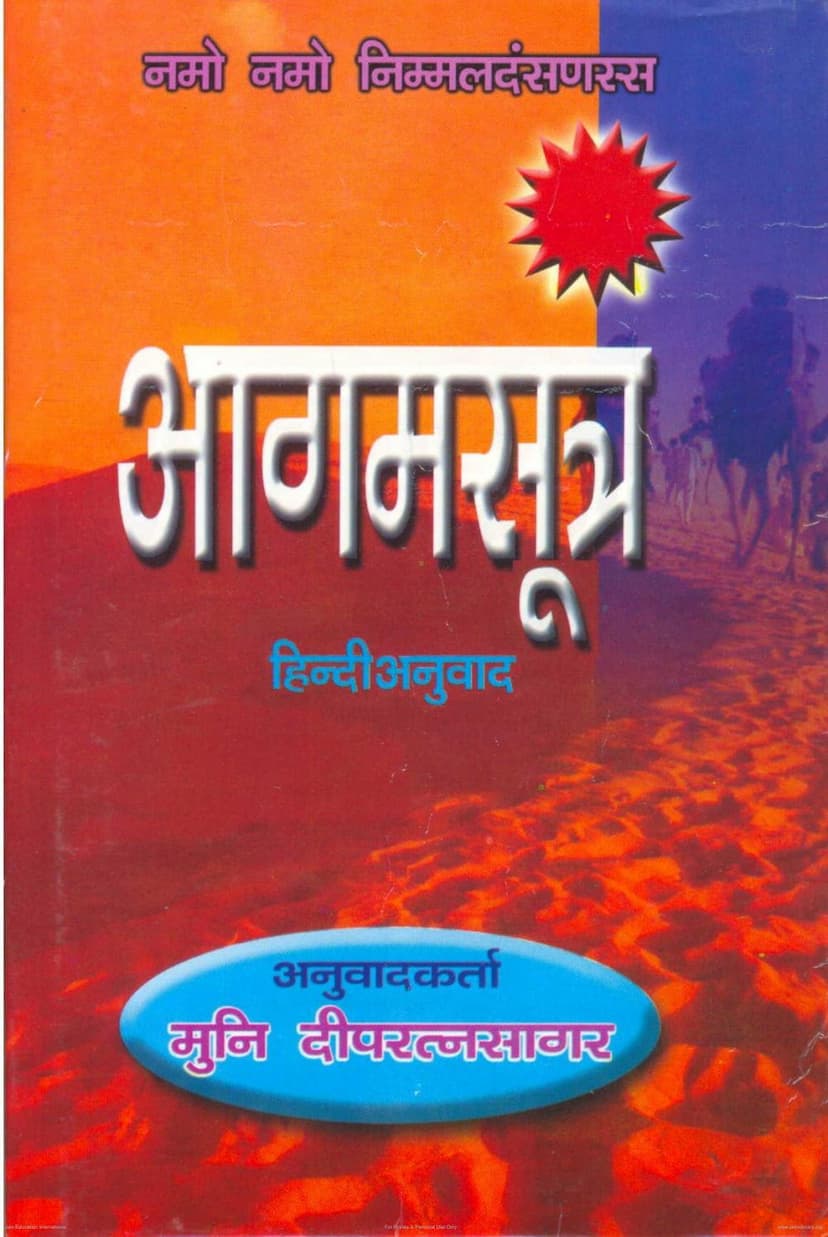Agam Sutra Hindi Anuvad Part 06
Added to library: September 1, 2025
Loading image...

Summary
This document is the sixth volume of the Hindi translation of the Agam Sutra, translated by Muni Deepratnasagar. It covers several key Jain texts:
- Antakṛtdaśā (अन्तकृतदशा): This section details the lives of ascetics who achieved liberation, focusing on their austerities and ultimate salvation. The text is structured into eight sections (varga), each containing several studies (adhyayan). The summary provides a glimpse into the narratives of individuals like Gautam, Samudra, Sagar, and others, highlighting their spiritual journeys, renunciation, and attainment of liberation, often on Mount Shatrunjaya. The lives of prominent figures like Krishna Vasudev, Baldev, and the Yadavas are also referenced in relation to the stories. The text describes the hardships faced by ascetics, their adherence to vows, and the ultimate rewards of their spiritual practice.
- Anuttaropapātikadaśā (अनुत्तरोपपातिकदशा): This part discusses beings born in the highest heavens (Anuttara heavens) and their extraordinary characteristics and destinies. It categorizes these beings into classes and describes their lives, qualities, and eventual rebirths. The focus is on beings whose existence and experiences transcend the ordinary, often highlighting their immense spiritual merit and the unique nature of their celestial abodes.
- Praśnavyākaraṇa (प्रश्नव्याकरण): This text is a dialogue between Lord Mahavir and his disciple Gautam Swami, where Gautam asks questions about the principles of Jainism. This volume covers the first part of Praśnavyākaraṇa, focusing on the "Āśrava dvāra" (means of influx of karmas) and "Saṃvara dvāra" (means of blocking karmic influx).
- Āśrava dvāra (आस्रव द्वार): This section details the five sources of karmic influx: violence (hiṃsā), falsehood (mṛṣā), theft (adattādāna), unchastity (abrahma-carya), and excessive possession (parigraha). It elaborates on the nature of violence, its various forms, and the terrible consequences in hells and animal realms. It also discusses the corrupting nature of falsehood, the suffering caused by theft, the pervasiveness of sensuality, and the endless cycle of suffering brought about by attachment and possession. The text lists numerous names and descriptions for each of these negative actions, emphasizing their karmic repercussions.
- Saṃvara dvāra (संवर द्वार): This section discusses the means of stopping the influx of karmas, which are the five great vows (Mahavratas): Ahimsa (non-violence), Satya (truthfulness), Asteya (non-stealing), Brahmacharya (celibacy), and Aparigraha (non-possession). It elaborates on the virtues and practices associated with each vow, emphasizing their role in spiritual purification and liberation. The text details the strict disciplines and ethical conduct required for observing these vows.
- Vipākaśruta (विपाकश्रुत): This text describes the consequences of actions (karmas) in this life and future lives, focusing on the results of both good and bad deeds. The volume covers the first part of Vipākaśruta, detailing the "duḥkhavipāka" (results of suffering) caused by negative actions. It recounts stories of individuals who experienced severe karmic consequences due to their past wrongdoings, such as the tragic lives of Mrigaputra, Ujjhitaka, Abhagenasen, Shakata, Bṛhaspati, Nandivardhana, Umbardatta, Shaurikadatta, Devadatta, and Anju. These narratives often depict rebirths in hells, as animals, or in suffering human lives, emphasizing the chain of cause and effect in karma.
- Aupapātika (औपपातिक): This text describes extraordinary births and celestial beings. The volume covers the initial parts, detailing the city of Champa, the sacred Chaitra, the virtuous King Kunik, and his queen Dharini. It also describes the celestial beings of Suryaabha Viman and their divine activities, as well as the lives of great souls like the Ascetic Keshi Kumar and King Pradeshi, illustrating the Jain principles of karma, rebirth, and the path to liberation. The text touches upon the teachings of Lord Mahavir and the intellectual prowess of Gautam Swami in explaining these profound concepts.
- Rajprashniya (राजप्रश्रीय): This text is presented as a dialogue between King Pradeshin of the kingdom of Shravasti and Muni Keshikumara. The dialogue centers on King Pradeshin's doubts about the nature of the soul and the body, and his adherence to the theory of "Jeev is Sharir" (soul is body). Muni Keshikumara skillfully uses parables and logic to explain the Jain philosophy of soul-body dualism and the consequences of one's actions. The text highlights the importance of right faith and the liberation from karmic bondage through adherence to Jain principles.
In essence, this volume provides detailed narratives and philosophical expositions from core Jain scriptures, emphasizing the principles of karma, renunciation, spiritual discipline, and the ultimate goal of liberation. The translation aims to make these profound teachings accessible in Hindi.